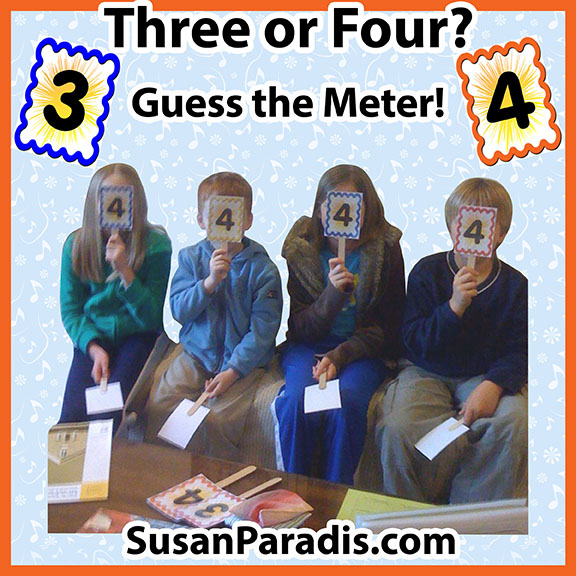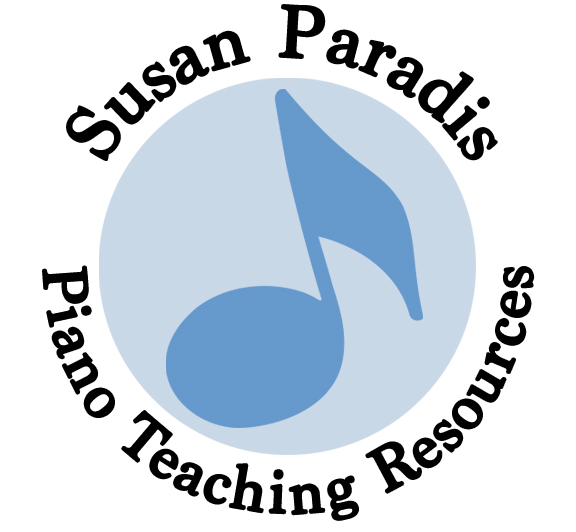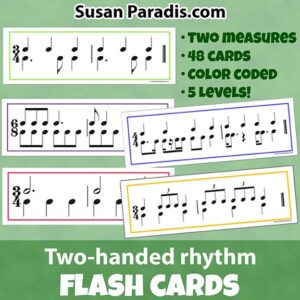Three or Four?

I like to give my students something to listen for when they play for each other at group lessons. I was watching the Olympics and decided it would be fun to hold up numbers at the end of each piece like the judges in some of the competitions. But our numbers are not a rating. Students have to listen to each piece and decide if the meter is in 3 or 4.
The older group had one piece in 6/8, but it was played rather slowly, so students felt it in 3. This gave us an opportunity to discuss how 6/8 should be felt in 2 when it is played up to tempo and I was gratified that the students remembered what I was talking about.
Another student played a piece in 4/4 time with accents grouped in threes in the first few bars that faked everyone out. Students learned they need to listen to the entire piece.
When I first announced we were going to play Three or Four, it was interesting watching the younger students quickly open their music to check out their time signature. So we were able to discuss why they should know the meter and key signature of their own piece! The games we play in group lessons usually lead to some interesting musical discussions, and hopefully some new things learned.
If you want to try this activity, here is how to make the signs. Click on the link under the cards. That will take you to my website. Click on “download” to print. After printing the PDF, cut the cards out and paste to large size popsicle sticks. I put 2 cards back to back and laminated them in my home laminating machine. That way the back of the cards we not laminated and stuck a lot better to the popsicle sticks. After I cut out the cards, it looked like the laminating material might pull off, so I put them through the laminating machine again. That worked great. I used a glue gun for the adhesive because kids can be rough. They used the cards to keep time on their knees!
Students had a lot of fun holding up them up, and it gave them something to listen for, which is sometimes hard for students.
Now that I have the cards, I’m going to try and come up with some other way to use them. Any ideas? 🙂



Susan,
I would love to see more cards for different time signatures. I will use the ones you have for group class this week. Thanks!
Roxane Lee
I have printed these out, cut them out and laminated them. Thanks 😀 I’m looking forward to being able to use them with my students.
I’d love the 6/8 ones as well and I know it might be a huge request, but 2/4 would be fantastic. That would mean I can use them with my theory students, as 2/4, 3/4 and 4/4 are all standard First Grade theory time signatures here. Add 6/8 time together with those for Second Grade. (Australian theory, that is)
I really appreciate all the time and hard work you put into these games. It mustn’t be easy, but boy do students absolutely adore the games 🙂 And so do I!
I like your idea a lot.
It is a great use to listen the intervals too or chords (root, third, fifth), or the scale steps number (for the last one I would prefer roman numbers).
It is possible to use the cards 1, 2, 3, 4, 5 for fingers in the game when a teacher plays a short patterns going up, down or same,for example,three notes stepping up, and asking a student which fingers on the L.H. or R. H. can play it etc.
Thank you Susan.
Yelena.
How fun, Susan! I have a “listening board” for my younger students’ group lessons where they have to listen for dynamics, articulation, meter, tempo, range, mood, etc. I just have small squares students can velcro on to a foam board. The signs would be a lot easier for the kids to stay in their seats, and a fun way to “judge” the performer and give instant feedback without taking up too much precious time! Thanks for all your excellent ideas, Susan!
Sorry–I just emailed you and then noticed this spot for comments. I like your idea for ‘three or four’ and just printed them out. I will laminate them and then try using double sided scrap booking tape on the back to hold the stick. I may use a small strip of shipping tape over the stick as well. Good idea.
You are amazing! I’ve been working with some students in preparation for ear-training musicianship phase for Guild auditions – recognizing time signatures.
Thank you!
Deborah
Thank you, Deborah. If I get enough requests, I’ll make some for 6/8. I think my students really enjoyed it, and it is an activity that doesn’t take any time in a group lesson if students are performing anyway.